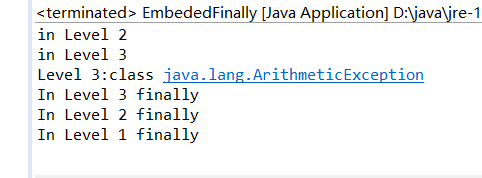1.请阅读并运行AboutException.java示例。
import javax.swing.*; class AboutException { public static void main(String[] a) { int i=1, j=0, k; k=i/j; try { k = i/j; // Causes division-by-zero exception //throw new Exception("Hello.Exception!"); } catch ( ArithmeticException e) { System.out.println("被0除. "+ e.getMessage()); } catch (Exception e) { if (e instanceof ArithmeticException) System.out.println("被0除"); else { System.out.println(e.getMessage()); } } finally { JOptionPane.showConfirmDialog(null,"OK"); } } }
运行结果:

2.多层的异常捕获-1
阅读以下代码(CatchWho.java),写出程序运行结果。
public class CatchWho { public static void main(String[] args) { try { try { throw new ArrayIndexOutOfBoundsException(); } catch(ArrayIndexOutOfBoundsException e) { System.out.println( "ArrayIndexOutOfBoundsException" + "/内层try-catch"); } throw new ArithmeticException(); } catch(ArithmeticException e) { System.out.println("发生ArithmeticException"); } catch(ArrayIndexOutOfBoundsException e) { System.out.println( "ArrayIndexOutOfBoundsException" + "/外层try-catch"); } } }
运行结果:

分析:程序运行到第五行时抛出ArrayIndexOutOfBoundsException();该异常被第16行的catch语句捕获,
多层的异常捕获-2
写出CatchWho2.java程序运行的结果
public class CatchWho2 { public static void main(String[] args) { try { try { throw new ArrayIndexOutOfBoundsException(); } catch(ArithmeticException e) { System.out.println( "ArrayIndexOutOfBoundsException" + "/内层try-catch"); } throw new ArithmeticException(); } catch(ArithmeticException e) { System.out.println("发生ArithmeticException"); } catch(ArrayIndexOutOfBoundsException e) { System.out.println( "ArrayIndexOutOfBoundsException" + "/外层try-catch"); } } }
运行结果:

分析:程序运行到第5行时抛出ArrayIndexOutOfBoundsException();该异常被第15行的catch语句捕获
总结:
(1).异常捕获时可以有多个catch语句块,每个代码块捕获一种异常。
(2).在某个try块后有两个不同的catch 块捕获两个相同类型的异常是语法错误。
(3).使用catch语句,只能捕获Exception类及其子类的对象。因此,一个捕获Exception对象的catch语句块可以捕获所有“可捕获”的异常。
(4).将catch(Exception e)放在别的catch块前面会使这些catch块都不执行,因此Java不会编译这个程序。
3.当有多个嵌套的try...catch....finally时,要特别注意finally的执行时机,请先阅读EmbedFinally.java示例,再运行它,观察其输出再进行总结。
public class EmbededFinally { public static void main(String args[]) { int result; try { System.out.println("in Level 1"); try { System.out.println("in Level 2"); // result=100/0; //Level 2 try { System.out.println("in Level 3"); result=100/0; //Level 3 } catch (Exception e) { System.out.println("Level 3:" + e.getClass().toString()); } finally { System.out.println("In Level 3 finally"); } // result=100/0; //Level 2 } catch (Exception e) { System.out.println("Level 2:" + e.getClass().toString()); } finally { System.out.println("In Level 2 finally"); } // result = 100 / 0; //level 1 } catch (Exception e) { System.out.println("Level 1:" + e.getClass().toString()); } finally { System.out.println("In Level 1 finally"); } } }
结果:

特别注意:当有多层嵌套的finally时,异常在不同层次抛出,在不同的位置抛出,可能导致不同的finally语句执行顺序
4.finally语句块一定会执行吗?请通过SystemExitAndFinally.java示例程序回答上述问题。
public class SystemExitAndFinally { public static void main(String[] args) { try{ System.out.println("in main"); throw new Exception("Exception is thrown in main"); //System.exit(0); } catch(Exception e) { System.out.println(e.getMessage()); System.exit(0); } finally { System.out.println("in finally"); } } }
结果:

分析总结:
(1)try语句没有被执行到,如在try语句之前return就返回了,这样finally语句就不会执行。这也说明了finally语句被执行的必要而非充分条件是:相应的try语句一定被执行到。
(2)在try块|catch块中有System.exit(0);这样的语句。System.exit(0)是终止Java虚拟机JVM的,连JVM都停止了,所有都结束了,当然finally语句也不会被执行到。